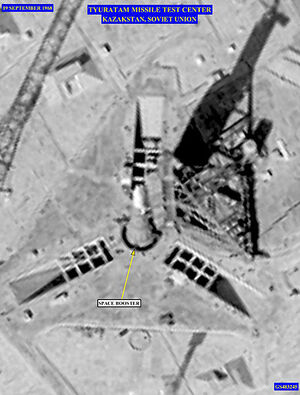N1 rocket (nonfiction)
The N1 (Russian: Н1, from Ракета-носитель, Raketa-Nositel, carrier) was a super heavy-lift launch vehicle intended to deliver payloads beyond low Earth orbit. Development work started in 1959.
N1 was the Soviet counterpart to the US Saturn V. It was designed with crewed extra-orbital travel in mind. Its first stage is the most powerful rocket stage ever built.
The N1-L3 version was developed to compete with the United States Apollo-Saturn V to land a man on the Moon, using the same lunar orbit rendezvous method. The basic N1 launch vehicle had three stages, which was to carry the L3 lunar payload into low Earth orbit with two cosmonauts. The L3 contained an Earth departure stage; another stage used for mid-course corrections, lunar orbit insertion, and powered descent initiation; a single-pilot LK Lander spacecraft; and a two-pilot Soyuz 7K-LOK lunar orbital spacecraft for return to Earth. The Apollo spacecraft was able to carry three astronauts (landing two on the Moon), and relied on the Saturn V's third stage for Earth departure.
N1-L3 was underfunded and rushed, starting development in October 1965, almost four years after the Saturn V. The project was badly derailed by the death of its chief designer Sergei Korolev in 1966.
Each of the four attempts to launch an N1 failed; during the second launch attempt the N1 rocket crashed back onto its launch pad shortly after liftoff and exploded, resulting in one of the largest artificial non-nuclear explosions in human history.
The N1 program was suspended in 1974, and in 1976 was officially canceled. Along with the rest of the Soviet manned lunar programs, the N1 was kept secret almost until the collapse of the Soviet Union in December 1991; information about the N1 was first published in 1989.
In the News
1967: Film director and arms dealer Egon Rhodomunde raises money for new film by selling shares in the upcoming N1 rocket explosion.
Fiction cross-reference
Nonfiction cross-reference
External links
- N1 (rocket) @ Wikipedia


